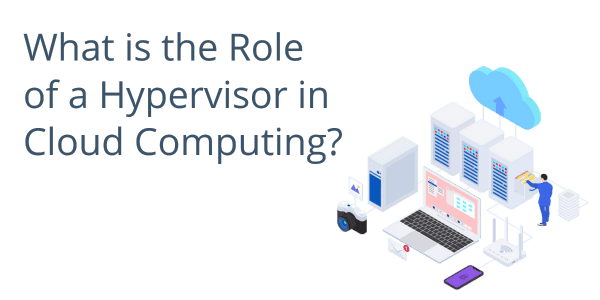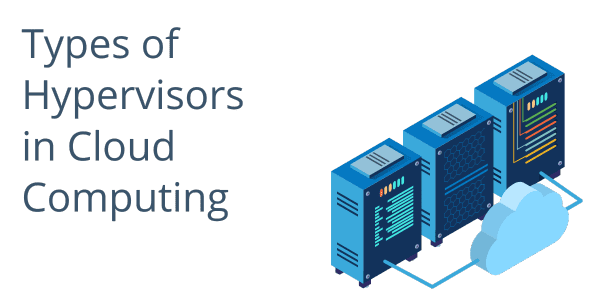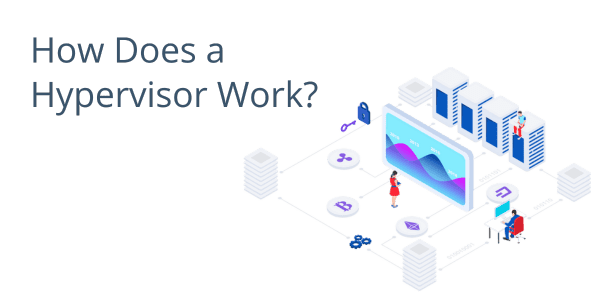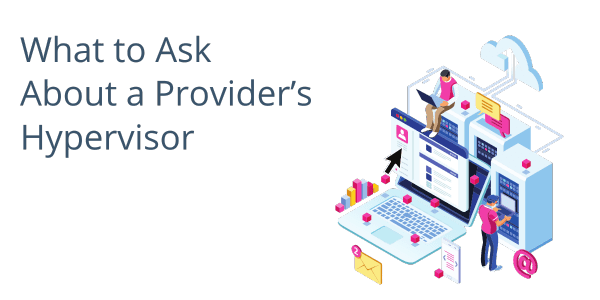Hypervisor-based cloud computing is a fundamental technology in the world of cloud infrastructure. The hypervisor manages the allocation of resources and ensures isolation between virtual machines (VMs), creating a secure and efficient virtualized environment.
As a business looking to choose a DaaS (Desktop as a Service) provider, you don’t need to delve deeply into the technical aspects of hypervisors.
However, it’s always helpful to have a basic understanding of how various pieces of hardware and software can impact your DaaS experience and what benefits they can offer.
Here’s what you need to know about hypervisors when considering a virtual desktop infrastructure (VDI) for your organization.
 What is the Role of a Hypervisor in Cloud Computing?
What is the Role of a Hypervisor in Cloud Computing?
In cloud computing, a hypervisor, also known as a virtual machine monitor (VMM), is a software or firmware layer that enables multiple VMs to run on a single physical server. The primary purpose of a hypervisor is to efficiently utilize the server’s resources by creating and managing isolated virtual environments, each of which behaves like a separate and independent computer.
 Types of Hypervisors in Cloud Computing
Types of Hypervisors in Cloud Computing
Although you won’t need all the technical details, it’s good to ask prospective providers about the type of hypervisor they use.
There are mainly two types:
- Type 1 (Bare-Metal)
- Type 2 (Hosted)
Type 1 hypervisors are generally preferred for enterprise-level performance, as they run directly on the server hardware. Bare metal hypervisors can host virtual machines with different types of operating systems.
This makes them valuable for running legacy applications and systems. This feature allows for smooth integration of existing infrastructure into the cloud without requiring extensive reconfigurations.
Type 2 hypervisors, or hosted hypervisors run on top of an operating system and are more suitable for development and testing environments. Developers and testers benefit from hypervisor-based cloud computing by easily creating isolated virtual environments.
These hypervisors can simulate various configurations without the need for dedicated physical hardware, reducing costs associated with setting up and maintaining separate testing and development environments.
 How Does a Hypervisor Work?
How Does a Hypervisor Work?
- Physical Server
The underlying hardware on which the hypervisor is installed is called the physical server. It has its own operating system, known as the host operating system.
- Hypervisor
The hypervisor is installed and it takes control of the server’s resources, such as CPU, memory, storage, and networking. It then manages the allocation of these resources among the virtual machines.
- Virtual Machines
Each virtual machine (VM) is an isolated and self-contained environment that emulates a complete computer system. It has its own virtual CPU, memory, disk space, and network interface.
Multiple VMs can run simultaneously on the same physical server, each running its operating system (e.g., Windows, Linux) and applications.
 What to Ask About a Provider’s Hypervisor
What to Ask About a Provider’s Hypervisor
The choice of hypervisor can impact the performance and scalability of your virtual desktops, so It’s worth discussing with a potential provider. Ask about their infrastructure capabilities, including the number of virtual desktops they can efficiently host and how they manage resource allocation to ensure smooth performance.
Hypervisors provide isolation between virtual machines, which enhances security. Each virtual desktop is separate from others, better shielding its data and applications from potential threats. You should be clear about the provider’s security measures and data protection practices.
Be clear that the provider’s hypervisor supports the operating systems and applications your business relies on. Compatibility is crucial to ensure that your existing software and tools can be smoothly migrated to the virtual desktop environment.
Hypervisors play a role in centralizing management and updates for virtual desktops. It’s essential to understand how a provider handles maintenance, software updates, and how they address any potential issues that may arise.
Consider the reputation and reliability of the provider and the hypervisor technology they use. Look at customer reviews, industry recognition, and testimonials to gauge the quality of their services.
For some providers, their choice of hypervisor can also influence the pricing model and overall cost of the DaaS service they offer you. Understand how the provider structures their pricing, including factors like the number of users, storage usage, and any additional features or support options. Be sure they present you with a clearly written service level agreement (SLA) so you know what you’re ultimately paying for.
In Conclusion
While you don’t need to become an expert in hypervisors, having a basic understanding of their role and impact on your virtual environment will help you make informed decisions when selecting a provider.
Focus on the overall benefits, performance, security, and compatibility of the DaaS solution offered by the provider and seek information on how they handle management and support for a seamless VDI experience.
Need Help Making Your Network More Robust, Increasing Business Productivity, Or Capping Escalating Technology Costs?
Our trained team of cloud computing experts can help you by developing the most secure and efficient cloud-based storage and processing solutions for your business.
Let us demonstrate exactly what Cyberlink can do for you – using your own data and workflows.


 Types of Hypervisors in Cloud Computing
Types of Hypervisors in Cloud Computing How Does a Hypervisor Work?
How Does a Hypervisor Work? What to Ask About a Provider’s Hypervisor
What to Ask About a Provider’s Hypervisor